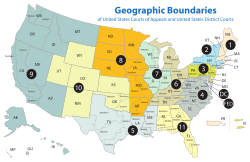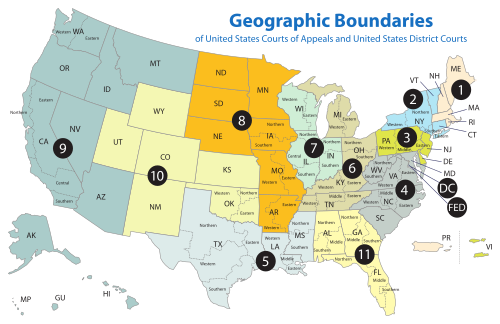Region Citation Court of Established Judges Meeting Chief judge Northern District of Alabama N.D. Ala. 11th 1824 8 8 R. David Proctor Middle District of Alabama M.D. Ala. 11th 1839 3 3 Emily C. Marks Southern District of Alabama S.D. Ala. 11th 1824 3 2 Jeff Beaverstock District of Alaska D. Alaska 9th 1958 3 5 Sharon L. Gleason District of Arizona D. Ariz. 9th 1910 13 6 Jennifer Zipps Eastern District of Arkansas E.D. Ark. 8th 1851 5 3 Kristine Baker Western District of Arkansas W.D. Ark. 8th 1851 3 6 Timothy L. Brooks Central District of California C.D. Cal. 9th 1966 28 4 Dolly Gee Eastern District of California E.D. Cal. 9th 1966 6 3 Troy L. Nunley Northern District of California N.D. Cal. 9th 1886 14 4 Richard Seeborg Southern District of California S.D. Cal. 9th 1850 13 1 Cynthia Bashant District of Colorado D. Col. or D. Colo. 10th 1876 7 8 Philip A. Brimmer District of Connecticut D. Conn. 2nd 1789 8 5 Michael P. Shea District of Delaware D. Del. 3rd 1789 4 1 Colm Connolly District of the District of Columbia D.D.C. D.C. 1863 15 1 James Boasberg Northern District of Florida N.D. Fla. or N.D. Fl. 11th 1847 4 6 Allen Winsor Middle District of Florida M.D. Fla. or M.D. Fl. 11th 1962 15 8 Marcia Morales Howard Southern District of Florida S.D. Fla. or S.D. Fl. 11th 1847 18 5 Cecilia Altonaga Northern District of Georgia N.D. Ga. 11th 1848 11 4 Leigh Martin May Middle District of Georgia M.D. Ga. 11th 1926 4 7 Leslie Abrams Gardner Southern District of Georgia S.D. Ga. 11th 1848 3 6 R. Stan Baker District of Guam D. Guam 9th 1951 1 1 Frances Tydingco-Gatewood District of Hawaii D. Haw. 9th 1959 4 1 Derrick Watson District of Idaho D. Idaho 9th 1890 2 4 David Nye Northern District of Illinois N.D. Ill. 7th 1855 23 4 Virginia Mary Kendall Central District of Illinois C.D. Ill. 7th 1978 4 6 Sara Darrow Southern District of Illinois S.D. Ill. 7th 1855 4 4 Nancy J. Rosenstengel Northern District of Indiana N.D. Ind. 7th 1928 5 4 Holly A. Brady Southern District of Indiana S.D. Ind. 7th 1928 5 5 James R. Sweeney II Northern District of Iowa N.D. Iowa 8th 1882 2 6 C. J. Williams Southern District of Iowa S.D. Iowa 8th 1882 3 6 Stephanie M. Rose District of Kansas D. Kan. 10th 1861 6 9 John W. Broomes Eastern District of Kentucky E.D. Ky. 6th 1901 6 9 David Bunning Western District of Kentucky W.D. Ky. 6th 1901 5 4 David J. Hale Eastern District of Louisiana E.D. La. 5th 1849 12 2 Wendy Vitter Middle District of Louisiana M.D. La. 5th 1971 3 1 Shelly Dick Western District of Louisiana W.D. La. 5th 1881 7 6 Terry A. Doughty District of Maine D. Me. 1st 1789 3 2 Lance E. Walker District of Maryland D. Md. 4th 1789 10 4 George L. Russell III District of Massachusetts D. Mass. 1st 1789 13 4 Denise J. Casper Eastern District of Michigan E.D. Mich. 6th 1863 15 5 Stephen Murphy III Western District of Michigan W.D. Mich. 6th 1863 4 6 Hala Y. Jarbou District of Minnesota D. Minn. 8th 1858 7 6 Patrick J. Schiltz Northern District of Mississippi N.D. Miss. 5th 1838 3 7 Debra M. Brown Southern District of Mississippi S.D. Miss. 5th 1838 6 7 Halil Suleyman Ozerden Eastern District of Missouri E.D. Mo. 8th 1857 9 3 Stephen R. Clark Western District of Missouri W.D. Mo. 8th 1857 7 5 Mary Elizabeth Phillips District of Montana D. Mont. 9th 1889 3 11 Brian Morris District of Nebraska D. Neb. 8th 1867 3 3 Robert F. Rossiter Jr. District of Nevada D. Nev. 9th 1865 7 6 Andrew P. Gordon District of New Hampshire D.N.H. 1st 1789 3 2 Samantha D. Elliott District of New Jersey D.N.J. 3rd 1789 17 6 Renée Marie Bumb District of New Mexico D.N.M. 10th 1910 7 3 Kenneth J. Gonzales Eastern District of New York E.D.N.Y. 2nd 1865 15 4 Margo Kitsy Brodie Northern District of New York N.D.N.Y. 2nd 1814 5 8 Brenda K. Sannes Southern District of New York S.D.N.Y. 2nd 1814 28 3 Laura Taylor Swain Western District of New York W.D.N.Y. 2nd 1900 4 5 Elizabeth A. Wolford Eastern District of North Carolina E.D.N.C. 4th 1872 4 7 Richard E. Myers II Middle District of North Carolina M.D.N.C. 4th 1927 4 3 Catherine Eagles Western District of North Carolina W.D.N.C. 4th 1872 5 5 Martin Karl Reidinger District of North Dakota D.N.D. 8th 1890 2 4 Peter D. Welte District of the Northern Mariana Islands D.N. Mar. I. 9th 1977 1 1 Ramona Villagomez Manglona Northern District of Ohio N.D. Ohio 6th 1855 11 5 Sara Elizabeth Lioi Southern District of Ohio S.D. Ohio 6th 1855 8 5 Sarah D. Morrison Eastern District of Oklahoma E.D. Ok. or E.D. Okla. 10th 1906 2 8 Ronald A. White Northern District of Oklahoma N.D. Ok. or N.D. Okla. 10th 1925 4 5 John F. Heil III Western District of Oklahoma W.D. Ok. or W.D. Okla. 10th 1906 7 10 Timothy D. DeGiusti District of Oregon D. Or. or D. Ore. 9th 1859 6 7 Michael J. McShane Eastern District of Pennsylvania E.D. Pa. 3rd 1818 22 5 Wendy Beetlestone Middle District of Pennsylvania M.D. Pa. 3rd 1901 6 5 Matthew W. Brann Western District of Pennsylvania W.D. Pa. 3rd 1818 10 3 Mark R. Hornak District of Puerto Rico D.P.R. 1st 1966 7 3 Raúl M. Arias-Marxuach District of Rhode Island D.R.I. 1st 1790 3 1 John J. McConnell Jr. District of South Carolina D.S.C. 4th 1789 10 11 Timothy M. Cain District of South Dakota D.S.D. 8th 1889 3 5 Roberto Lange Eastern District of Tennessee E.D. Tenn. 6th 1802 5 4 Travis R. McDonough Middle District of Tennessee M.D. Tenn. 6th 1839 4 3 William L. Campbell Jr. Western District of Tennessee W.D. Tenn. 6th 1802 5 3 Sheryl H. Lipman Eastern District of Texas E.D. Tex. 5th 1857 8 7 Amos Mazzant Northern District of Texas N.D. Tex. 5th 1879 12 7 David C. Godbey Southern District of Texas S.D. Tex. 5th 1902 19 7 Randy Crane Western District of Texas W.D. Tex. 5th 1857 13 8 Alia Moses District of Utah D. Utah 10th 1894 5 4 Jill Parrish District of Vermont D. Vt. 2nd 1791 2 7 Christina Reiss District of the Virgin Islands D.V.I. 3rd 1936 2 2 Robert A. Molloy Eastern District of Virginia E.D. Va. 4th 1819 11 4 Mark Steven Davis Western District of Virginia W.D. Va. 4th 1819 4 7 Elizabeth K. Dillon Eastern District of Washington E.D. Wash. 9th 1905 4 4 Stanley Bastian Western District of Washington W.D. Wash. 9th 1905 7 3 David Estudillo Northern District of West Virginia N.D. W. Va. 4th 1901 3 5 Tom Kleeh Southern District of West Virginia S.D. W. Va. 4th 1901 5 6 Frank W. Volk Eastern District of Wisconsin E.D. Wis. 7th 1870 5 3 Pamela Pepper Western District of Wisconsin W.D. Wis. 7th 1870 2 5 James D. Peterson District of Wyoming D. Wyo. 10th 1890 3 6 Kelly H. Rankin 


